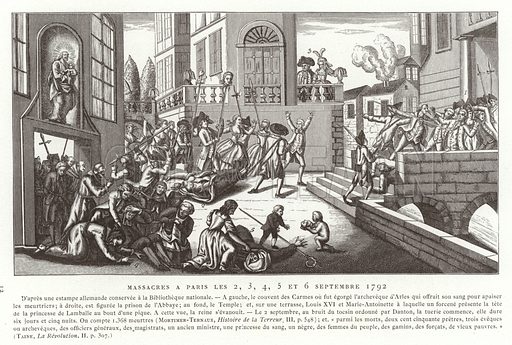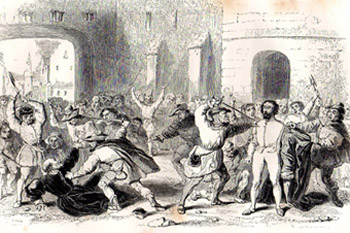Blessed James Bonnaud, William Defraud & 12 Companions, SJ
Blessed James Bonnaud, SJ 1740 – 1792,
Blessed William Defraud, SJ 1733 – 1792 & 12 Companions
Died : September 2, 1792
Beatified: October 26, 1926
 Blessed James Bonnaud and William Defraud and his 12 Companions were the 23 French Jesuits who were among the 191 French martyrs beatified by Pope Pius XI in 1926. They were massacred at the beginning of the French Revolution’s first Reign of Terror which began originally to right the wrongs the people suffered under aristocratic rule. However the revolution was gradually transformed into a rabid anti-Catholic persecution by its leaders.
Blessed James Bonnaud and William Defraud and his 12 Companions were the 23 French Jesuits who were among the 191 French martyrs beatified by Pope Pius XI in 1926. They were massacred at the beginning of the French Revolution’s first Reign of Terror which began originally to right the wrongs the people suffered under aristocratic rule. However the revolution was gradually transformed into a rabid anti-Catholic persecution by its leaders.
Prior to the revolution in 1762, the French liberals had succeeded in suppressing the Jesuits in France with the closure of their schools and forcing them into exile. Hence the 23 blessed commemorated on September 2 and 3 are sometimes called ex-Jesuits because their martyrdom took place in the years of the Society’s suppression. However Pope Pius honored them as Jesuits because they remained as Jesuits in desire and intention.
Many anti-Catholic decrees were enacted, initially dealing with the religious orders and later the diocesan clergy. All ecclesiastical property were placed at the disposal of the nation, suppression of monastic vows, forbidding religious orders from accepting new members and declaring all monks and nuns free to leave their monasteries. In 1790, the infamous Civil Constitution of the Clergy was enacted and a national church in France was constituted, totally independent of the Pope. It stipulated that bishops and priests were servants of the state and had to be elected by the people just as civil magistrates were elected. It was further decreed that all clergy were to take an oath to support this Civil Constitution, failing which they would lose their citizenship and the priests would be liable to prosecution as disturbers of the peace. Notwithstanding this only one-third of the parish clergy and only three of France’s forty-four bishops took it, resulting in those who refused the oath i.e. the nonjuring clergy having to relinquish their parishes in favour of the “constitutional” clergy.
Being divided, the French clergy turned to the Pope for guidance and direction. Pope Pius VI in 1791 condemned the Constitution as being based on heretical principles and rejected that ecclesiastical power depends on civil authority or that election of the pastors belongs to the people. Many of the priests who had previously taken the oath now retracted and those who had not taken it were encouraged in their struggle against the government’s anti-Catholicism. The government retaliated by decreeing that those who refused the oath would be suspect of rebellion against the country.
In the midst of the revolution, Austria and Prussia viewed the French Revolution as a threat and to protect themselves and their monarchical governments they invaded France and war was declared on April 10, 1792. The reign of Terror began on August 9, 1792 when a mob of rebels, filled with revolution and egalitarian ideals, overthrew the king and imprisoned him and the royal family. With the dissolution of the monarchy, a commune was established which decreed that the nonjuring clergy were to be deported to South America and all nonjuring priests were hunted down and arrested. As the prisons were already crowded with political prisoners, the commune turned several Paris seminaries and monasteries into improvised prisons for priests. The commune’s more radical members directed a certain Commissar Stanislas Maillard to see to the clergymen’s dispatch but the Commissar and his men initiated to have them massacred instead on the pretext that the imprisoned clergy were plotting an uprising. They went to the Abbey of Saint-Germaine-des-Pres and there they massacred twenty-one of the Blessed (no Jesuits among this group). Their next stop was at the Carmelite monastery where more than a hundred priests were imprisoned in its chapel. Maillard’s group was by then augmented by blood-thirsty bandits, who cold-bloodedly clubbed to death ninety-five priests, most of whom were taking their exercise in the garden. Among this group, fourteen were Jesuits whose names and brief descriptions are below:
FR James Julius Bonnaud was born in the West Indies, in today’s Haiti. He was taken to France as a child and was educated at the Jesuit school in La Fleche. He entered the Society on Dec 20, 1758 and taught for two years at Quimper, Brittany. He entered the seminary of Saint-Firmin and then went to Flanders for his theology when the Jesuits were expelled from France where he had earned degrees in theology and canon law. He returned to France and served in the diocese of Paris where he wrote several scholarly works before his transfer to Lyons in 1788 to take up his appointment as the archbishop’s vicar general. During his tenure, Fr Bonnaud, in the archbishop’s Lentern pastoral letter, warned the faithful of an imminent persecution against all institutions, political, civil and religious. He continued to write against the revolutionaries and their anti-papal Civil Constitution and staunchly defended the rights of the Church. This made him a prime target for the revolutionaries to silence him. He was arrested sometime after August 10, 1792 and was among those imprisoned at the Carmelite monastery where he received his martyrdom for Christ on Sep 2, 1792.
FR William Anthony Delfaud was born at L’Estang-de-Lol, near Daglan, today’s Sarlat. He entered the Society on Oct 21, 1752, at Toulouse. He taught for a while at Mauriac, Montpellie, and Cahors, and then went to Tournon for theology. When the French Jesuits were suppressed, he returned to his home diocese to complete his courses and was ordained in 1764. He remained at the Sarlat seminary as professor until 1770. Fr Delfaud succeeded his uncle as archpriest of Daglan and was also the States General at Versailles. He wrote publicly to his parishioners warning them against the growing strength of the anti-Catholic movement and refused to take the oath to support the Civil Constitution. Together with Fr Claude Laporte, he wrote attesting their willingness to shed their blood for religion’s sake. He was specially singled out for his bold and unrelenting opposition to the revolution and was arrested sometime after August 10, 1792 while he was at the Eudists, a congregation founded by St John Eudes. He was detained at the Carmelite monastery and a few hours before his martyrdom on Sep 2, 1792, he sent this message to friends: “Tell them that I have never felt better nor happier.”
 Fr Delfaud’s 12 companions in martyrdom were:
Fr Delfaud’s 12 companions in martyrdom were:
Fr Francis Balmain born at Luzy, Nevers on May 25, 1733 was ordained a Jesuit on July 20, 1753. He taught theology and later became chaplain for the Daughters of the Cross when the Jesuits were suppressed in France. He too was arrested at the house of the Eudists and later taken to the Carmelite monastery where he was martyred.
Fr Charles Berauld du Perou was born in Meursac, in the diocese of Las Rochelle, on Nov 17, 1737. He entered the Society in Paris on Sep 19, 1753. When the Society was suppressed in 1762, he went to Saint-Firmin and later to Pont-a-mousson in Lorraine where the Jesuits still maintained their schools. He too was in the house of the Eudists in Paris when he was arrested and taken to Carmelite monastery where he was martyred.
Fr Claude Cayx-Dumas was born on Nov 6, 1724, at Martel in southern France. He entered the Society on Oct 8, 1744 at Toulouse where he taught for several years after his noviceship and philosophy He taught at Clermont College after his ordination. He devoted himself to apostolic works for twenty-five years when the Society was suppressed and was chaplain to the Ursuline Sisters of Saint-Cloud in Versailles. He was arrested while he was in retirement at the St Francis de Sales Home for priests at Issy, outside Paris. In his late sixties, he was arrested together with two other Jesuits, Fr Claude Gagnieres des Granges and Fr Francis Vareilhe-Duteil and taken to the Carmelite monastery where they were martyred.
Fr John Charton de Millou was born in Lyons on Oct 17, 1736 and entered the Society on Sep 7, 1751. After his noviceship and philosophy, he taught before doing his theology. After one year, when the Society was suppressed, he had to finish his course in a diocesan seminary and was ordained. He was chaplain to the Sisters of the Most Blessed Sacrament and was a well known preacher in Paris and an excellent spiritual director. He brought many into the Church and his success made him a target with the revolutionaries. Although he changed his name to de Millou he was arrested and detained at the Carmelite monastery and martyred there.
Fr James Friteyre-Durve was born on April 18, 1726, at Marsac, Auvergne, and entered the Society at Toulouse on August 30, 1742. He taught before his theological studies at Tournon and was ordained in 1755. During the suppression, he worked in Paris and was well known as an excellent preacher. He preached a series of Lentern sermons at the royal court and another series at the Notre Dame Cathedral. For his contribution, Louis XVI granted him a pension and made him a canon at Saint-Denis which he relinquished to live a community life with the Eudists. When the revolution came with its persecution, Fr Durve would dress as a merchant, visit the houses of Catholics in Paris, especially those sick and dying. Although he changed his residence frequently to escape detection, he was arrested and when he refused to take the oath to the Civil Constitution, he was imprisoned at the Carmelite monastery. He was the first to be martyred when walking in the garden and clubbed to death by Maillard and his men.
Fr Claude Laporte was born in Brittany on Dec 6, 1734, He entered the Society in Paris on Sep 24, 1753 and when the Society was suppressed, he studied at the diocesan seminary and ordained in 1763. He was chaplain at the Brest Naval College and later assistant pastor at the Saint-Louis parish. When he refused to take the oath, he left Brest for Paris where he was arrested and later martyred.
Fr Mathurin Le Bous de Villeneuve was born at Rennes on Dec 19, 1731. He entered the Society in Paris on Sep 27, 1751. He became chaplain to the Benedictine Sisters on rue Bellechasse in Paris when the Society was suppressed. He was arrested in 1792 and imprisoned at the Carmelite monastery where he was clubbed to death on Sep 2, 1792.
Fr Claude Le Gue was born at Rennes on Oct 6, 1724and entered the Society in Paris on Dec 28, 1741 and was ordained in 1762. He was a prefect of students when the Society was suppressed and took up preaching at the Parisian churches. He also gave lentern sermons before the royal court at Versailles. As he felt called to live in community, he joined Fr Peter Joseph de Cloriviere and four other like-minded priests in founding the Society of the Sacred Heart of Jesus, a congregation in imitation of the suppressed Society of Jesus. He was arrested after Aug 10, 1792 for his refusal to support the Civil Constitution and was imprisoned in the Carmelite monastery where he was martyred.
Fr Vincent Le Rousseau de Rosancoat was born at Chateauneuf, Brittany on July 3, 1726. He entered the Society in Paris on Oct 11, 1743 and ordained in 1754. He taught philosophy at Nevers for eight years and returned to his hometown when the Society was suppressed to continue his priestly ministry. He was arrested when the revolutionaries came to the convent of the Sisters of the Visitation where he was chaplain to look for another priest, but finding Fr Le Rousseau, they took him instead. He was taken to the Carmelite monastery and martyred.
Fr LoupThomas-Bonnotte was born on September 13, 1719 at Entrains, Nevers and entered the Society in Nancy on Sep 7, 1734. Following his ordination, he had a successful career as a teacher of Scripture, literature and mathematics. When the Jesuit schools were closed during the suppression, he returned to his home diocese for ten years where he carried out his priestly ministry. He then became the chaplain to the Ursuline Sisters on rue Saint-Jacques until his arrest in Aug 1792 for refusing to take the oath. He was the oldest of the twenty-three Jesuits martyrs of the French Revolution when they were massacred at the Carmelite monastery on Sep 2, 1792.
Fr Francis Vareilhe-Duteil was born at Felletin in the diocese of Limoges on June 15, 1734. He entered the Society at Fontenay on Nov 22, 1751. He studied philosophy at Bordeaux and taught at Poitiers where he did his theology. When the French Jesuits were suppressed and expelled in 1762, he became a canon in a parish in Nancy. While taking a summer break to rest at St Francis de Sales Home for retired priests in Issy, he was arrested with ten other priests on Aug 15, 1792 when they refused to take the oath. They were taken to the Carmelite monastery and were martyred on Sep 2, 1792.
These fourteen Jesuits and the nine listed under Sep 3 were beatified by Pope Pius XI on October 17, 1926 together with 168 other French clergy.
